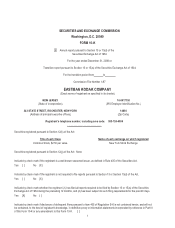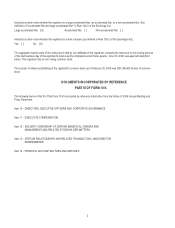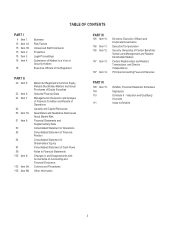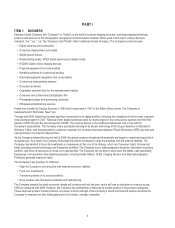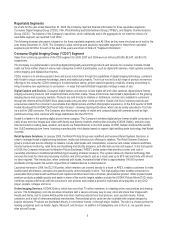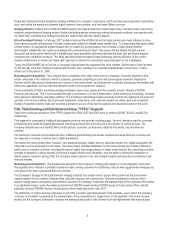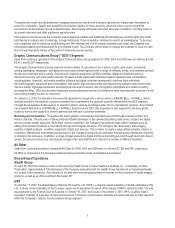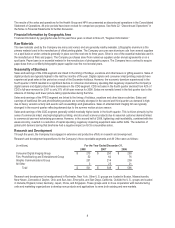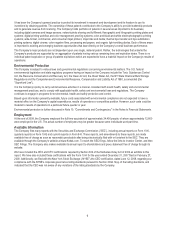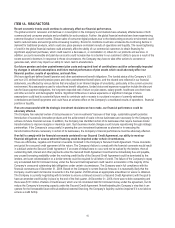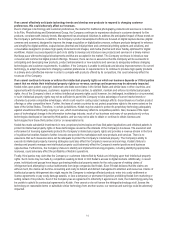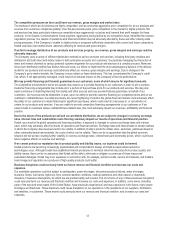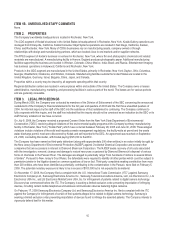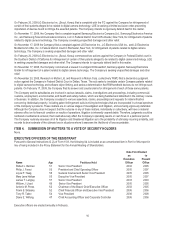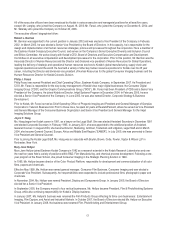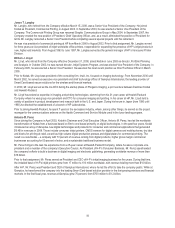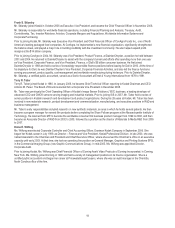Kodak 2008 Annual Report Download - page 12
Download and view the complete annual report
Please find page 12 of the 2008 Kodak annual report below. You can navigate through the pages in the report by either clicking on the pages listed below, or by using the keyword search tool below to find specific information within the annual report.10
ITEM 1A. RISK FACTORS
Recent economic trends could continue to adversely affect our financial performance.
The global economic recession and declines in consumption in the Company’s end markets have adversely affected sales of both
commercial and consumer products and profitability for such products. Further, the global financial markets have been experiencing
extreme disruption in recent months. Slower sales of consumer digital products due to the deteriorating economic environment could
lead to reduced sales and earnings while increasing inventory. Economic conditions could also accelerate the continuing decline in
demand for traditional products, which could also place pressure on Kodak’s results of operations and liquidity. The recent tightening
of credit in the global financial markets could adversely affect the ability of our commercial customers to obtain financing for
significant equipment purchases, which could result in a decrease in, or cancellation of, orders for our products and services. In
addition, accounts receivable and past due accounts could increase due to a decline in our customers’ ability to pay as a result of the
recent economic downturn. In response to these circumstances, the Company may have to take other actions to conserve or
generate cash, which may impact our ability to return cash to shareholders.
Our future pension and other postretirement plan costs and required level of contributions could be unfavorably impacted
by changes in actuarial assumptions and future market performance of plan assets which could adversely affect our
financial position, results of operations, and cash flow.
We have significant defined benefit pension and other postretirement benefit obligations. The funded status of the Company’s U.S.
and non-U.S. defined benefit pension plans and other postretirement benefit plans, and the related cost reflected in our financial
statements, are affected by various factors that are subject to an inherent degree of uncertainty, particularly in the current economic
environment. Key assumptions used to value these benefit obligations, funded status and expense recognition include the discount
rate for future payment obligations, the long-term expected rate of return on plan assets, salary growth, healthcare cost trend rate,
and other economic and demographic factors. Significant differences in actual experience or significant changes in future
assumptions could lead to a potential future need to contribute cash or assets to our plans in excess of currently estimated
contributions and benefit payments and could have an adverse effect on the Company's consolidated results of operations, financial
position or liquidity.
If we are unsuccessful with the strategic investment decisions we have made, our financial performance could be
adversely affected.
The Company has selected certain of its businesses as “core investments” because of their large, sustainable growth potential.
Introduction of successful innovative products and the achievement of scale in those businesses are necessary for the Company to
achieve its future financial success. In addition, the Company has identified certain of its businesses that require business model
transformations to improve margins or maximize cash. Such business model changes could include repositioning through strategic
partnerships. If the Company is unsuccessful in growing the core investment businesses as planned or in executing the
transformations that are necessary in certain of its businesses, the Company’s financial performance could be adversely affected.
If we fail to comply with the financial covenants contained in our Secured Credit Agreement, our ability to meet our
financial obligations or access external financing could be impaired under certain circumstances.
There are affirmative, negative and financial covenants contained in the Company’s Secured Credit Agreement. These covenants
are typical for a secured credit agreement of this nature. The Company’s failure to comply with the financial covenants would result
in a default under the Secured Credit Agreement. If an event of default were to occur and not be waived by the lenders, then all
outstanding debt, interest and other payments under the Secured Credit Agreement could become immediately due and payable,
any unused borrowing availability under the revolving credit facility of the Secured Credit Agreement could be terminated by the
lenders, and cash collateralization or a similar remedy could be required for all letters of credit. The failure of the Company to repay
any accelerated debt for borrowed money under the Secured Credit Agreement could result in acceleration of the majority of the
Company’s unsecured outstanding debt obligations under certain circumstances. The Company was in full compliance with the
financial covenants as of December 31, 2008. Based on the Company’s current financial forecast, it is reasonably likely that the
Company could breach its financial covenants in the first quarter of 2009 unless an appropriate amendment or waiver is obtained.
The Company is currently negotiating with its lenders to ensure continued access to a Secured Credit Agreement, with the goal to
have an amended credit facility in place by the end of the first quarter.At December 31, 2008, there was no debt outstanding and
there were $131 million of letters of credit issued, which are not considered debt for borrowed money under the agreement, but do
reduce the Company’s borrowing capacity under the Secured Credit Agreement. Notwithstanding the Company’s view that it can
operate for the foreseeable future without additional external financing, the Company’s liquidity could be impaired if it is not able to
access a credit facility.



